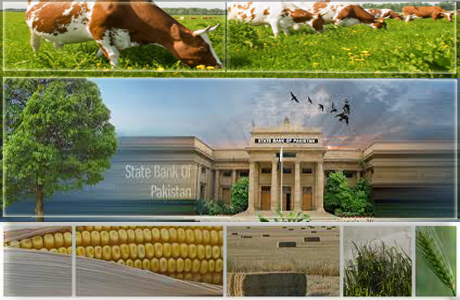Uneven agriculture credit
distribution
By Mohiuddin Aazim
 BANK
loans to the agriculture sector have been on a rise for some
years, but farmers of smaller provinces complain of uneven
credit distribution.
BANK
loans to the agriculture sector have been on a rise for some
years, but farmers of smaller provinces complain of uneven
credit distribution.
In FY13 and FY14, banks exceeded their indicative
agricultural lending target in Punjab, but they failed to
meet the targets set for the three other provinces and two
separate administrative divisions.
Banks’ lending to Punjab’s agriculture sector totalled
Rs293.3bn and Rs339.1bn in FY13 and FY14, against the target
of Rs246bn and Rs294.7bn respectively. This resulted in
overall higher-than-targeted agricultural lending of
Rs336.2bn in FY13 and Rs391.4bn in FY14 for the whole
country.
And the government and the
State Bank of Pakistan have highlighted this several times.
But the fact remains that farmers of Sindh, KP, Balochistan,
Azad Jammu and Kashmir (AJK) and Gilgit-Baltistan (GB)
received lesser-than-targeted agricultural loans.
This was not mentioned as
often, except for in SBP reports.
‘Provincial representatives in the agriculture credit
advisory body need to analyse what prevents banks from
distributing enough credit to smaller provinces, and suggest
corrective steps’.
In the two fiscal years, the
three smaller provinces and two administrative divisions
received Rs45.9bn and Rs52.2bn in agricultural loans,
against the indicative targets of Rs69bn and Rs85.3bn
respectively.
Bankers say agricultural lending in Sindh would pick up soon
as commercial banks as well as microfinance banks are
reaching out to underserved farmers. Besides, the Sindh Bank
is a catalyst for boosting all sorts of lending in the
province.
But banks in KP and Balochistan are not functioning properly
due to serious threats of militancy, and, thus, cannot
improve their farm lending there anytime soon.
In AJK, low agricultural
lending is attributed to banks’ lethargy, but in GB, the
problem of militancy and sectarian killings keep banks from
carrying out their routine operations.
Some bankers say a big reason
for low bank lending to farmers of smaller provinces is the
higher loan infection ratio. Compared to other provinces,
Punjab’s land records are better organised and have lesser
titling issues, which makes agricultural lending a bit
easier there, they say.
But it is difficult to verify their claim in the absence of
published records of province-wise breakup of non-performing
farm loans.
Farmers of smaller provinces, particularly of Sindh, say the
Zarai Taraqiati (agricultural development) Bank sets the
pace of farm lending for other commercial banks, adding that
low lending by ZTBL leads to below-target lending by
commercial banks as well.
Microfinance banks, however,
don’t follow their lead and have been lending more evenly
across the country. As a group, their agricultural loaning
exceeds the indicative target set for them.
One way to judge if banks are making agricultural loans
judiciously could be the relationship between the volume of
agricultural loans and the provinces’ share in the country’s
agricultural economy.
In FY13 and FY14, Punjab got 87.2pc and 86.6pc of total
agricultural financing, leaving just 12.8pc and 13.4pc for
the rest of the country respectively. Meanwhile, Punjab’s
share in the agricultural economy is no more than 60pc.
Besides, according to an Institute of Public Policy research
report authored by Mr Sartaj Aziz, Dr Hafiz Pasha and
veteran economists, agricultural growth in Punjab averaged
2.5pc between 2000 and 2010, against 2.7pc in the rest of
Pakistan.
In addition to geographical unevenness, agricultural loaning
also suffers from undue tilting in favour of farm
production, which effectively reduces lending for
development.
In the outgoing fiscal year, total agri credit distribution
stood at Rs391bn, of which Rs197bn (or over 50pc) was
offered for crop production and only Rs16bn (4.1pc) was lent
for agricultural development, SBP stats show.
The remaining amount was
channelled to other areas like corporate farms, livestock
and dairy sector, and fisheries and forestry.
Before FY14, the disbursement of agricultural development
loans was even worse. That is why the average annual
development lending between FY11 and FY14 comes to just
Rs10.7bn, or 3.33pc of the annual average agricultural
credit of Rs321bn during this period.
Since development loans for the farm sector are often used
to purchase tractors, tubewells, trolleys, power generators,
wheat thrashers, grain separators and other equipment and
machinery, low lending for development effectively impedes
farm mechanisation.
And that, in turn, makes it
difficult to enhance per-acre yields of crops.
Central bankers say the SBP has taken several measures in
the recent past to ensure faster disbursement of
agricultural development loans, including the introduction
of comprehensive and improved prudential regulations.
But they agree that something
needs to be done to push banks for more even agricultural
lending across all parts of the country.
Farmers say provincial representatives in the agriculture
credit advisory committee, which sets indicative
agricultural lending targets, need to analyse what prevents
banks from distributing enough farm credit to smaller
provinces, and suggest corrective measures.
January 2015
Courtesy:
Dawn News